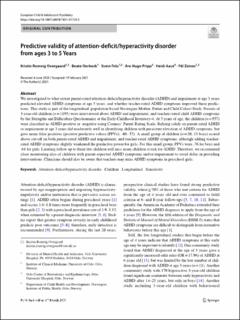Predictive validity of attention-deficit/hyperactivity disorder from ages 3 to 5 Years
Peer reviewed, Journal article
Published version

Permanent lenke
https://hdl.handle.net/11250/2980662Utgivelsesdato
2021Metadata
Vis full innførselSamlinger
- Artikler [5068]
- Publikasjoner fra CRIStin FHI [7544]
Sammendrag
We investigated to what extent parent-rated attention-deficit/hyperactivity disorder (ADHD) and impairment at age 3 years predicted elevated ADHD symptoms at age 5 years, and whether teacher-rated ADHD symptoms improved these predictions. This study is part of the longitudinal, population-based Norwegian Mother, Father and Child Cohort Study. Parents of 3-year-old children (n = 1195) were interviewed about ADHD and impairment, and teachers rated child ADHD symptoms by the Strengths and Difficulties Questionnaire or the Early Childhood Inventory-4. At 5 years of age, the children (n = 957) were classified as ADHD-positive or -negative using Conners’ Parent Rating Scale. Relying solely on parent-rated ADHD or impairment at age 3 years did moderately well in identifying children with persistent elevation of ADHD symptoms, but gave many false positives (positive predictive values (PPVs): .40–.57). A small group of children (n = 20, 13 boys) scored above cut-off on both parent-rated ADHD and impairment, and teacher-rated ADHD symptoms, although adding teacher-rated ADHD symptoms slightly weakened the predictive power for girls. For this small group, PPVs were .76 for boys and .64 for girls. Limiting follow-up to these few children will miss many children at risk for ADHD. Therefore, we recommend close monitoring also of children with parent-reported ADHD symptoms and/or impairment to avoid delay in providing interventions. Clinicians should also be aware that teachers may miss ADHD symptoms in preschool girls.